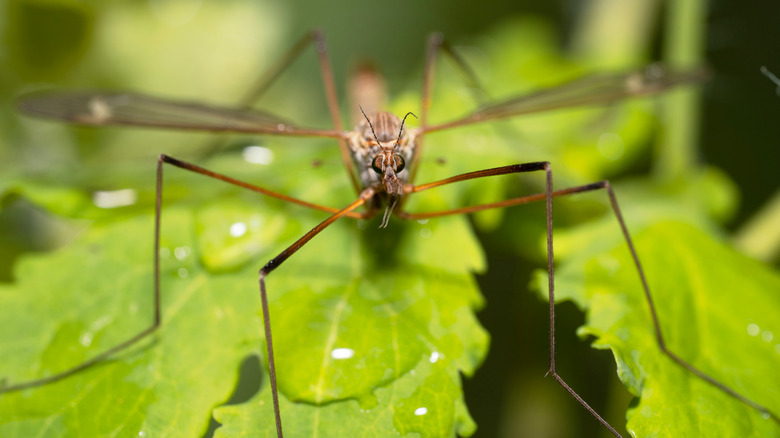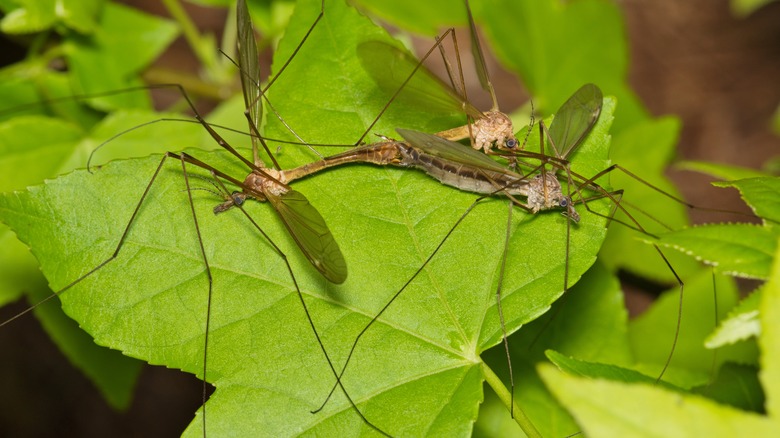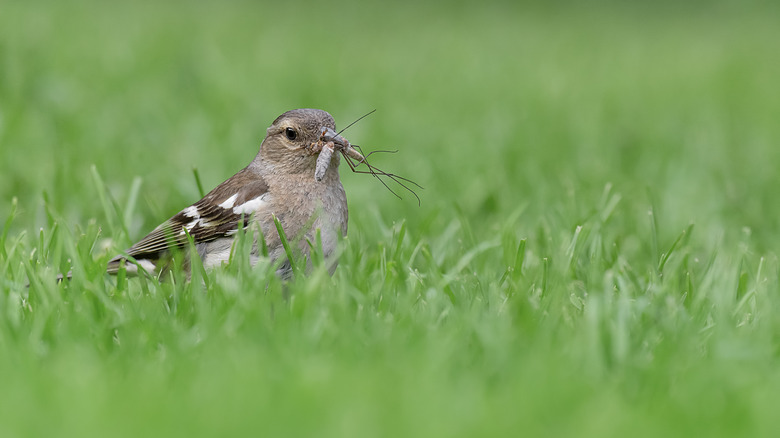Are Crane Flies Really Keeping Mosquitos Out Of Your Yard? Here's What We Know
Don't let that image worry you; a swarm of giant mosquitoes hasn't plagued your porch. Crane flies tend to emerge twice per year, usually around the early spring and fall, and for about two weeks they may flock to your porch lights or bounce around your garage. Dealing with swarms of crane flies can be annoying, especially if they slip inside your house every time you open the door, but could these bothersome insects actually serve some good in your garden? A popular rumor states that crane flies, also known as "mosquito hawks," will snatch up all your smaller, blood-sucking mosquitoes, so keeping them around is a good way to easily keep mosquitoes away from your pool and outdoor space. Unfortunately, this is a myth, crane flies don't dine on mosquitoes.
Crane flies look a bit like large, creepy mosquitoes, but other than sharing similar habitats, the two insect species have very little to do with each other. Here's what crane flies actually eat and the surprising benefits they can still bring to your garden, as well as some unexpected challenges they present.
Crane flies are lovers, not hunters
In many places, crane flies have nicknames like mosquito hawks, skeeter hawks, mosquito eaters, or skeeter eaters, but unfortunately, the idea that they hunt mosquitoes is purely a myth. Some people may also refer to crane flies as "mayflies," "daddy longlegs," or giant mosquitoes, but none of these nicknames are taxonomically accurate either. Crane flies are members of the Tipulidae family, under the larger umbrella of flies, order Diptera. If you look closely at the head of a crane fly they may appear to have large jaws that could catch mosquitoes mid-air, but in reality, crane flies have very small, simple mouthparts that can't catch prey or bite humans.
If "skeeter eaters" don't eat mosquitoes, what do they eat? As it turns out, most crane fly species don't eat much – they simply haven't evolved to do so. Dr. Jon Gelhaus, a crane fly specialist explains to Entomology Today, "Some can sponge up liquids, such as dew and honey water, but we don't see them do that much." Once they become adults, most crane flies only live for a few days and are more focused on finding mates, which explains why your porch may feel like a crane fly speed dating convention for a few weeks in the spring and fall.
Great for wildlife, bad for lawns
While they won't help with mosquitoes, a few types of crane flies can still provide benefits to your garden. "A number of them have independently evolved long mouthparts, and they'll visit flowers to take up nectar," says Dr. Jon Gelhaus (via Entomology Today). Crane flies that visit your flowers for nectar may help with pollination, especially for night-blooming flowers. Aside from being potentially helpful pollinators, crane flies also serve an important role as prey for other animals. Crane flies may not get rid of mosquitoes, but many other critters can. Lizards, frogs, swallows, and predatory insects may enjoy snacking on the long-legged crane flies or their larvae while simultaneously hunting mosquitoes in your yard.
However, lawn-owners may want to be wary of the crane flies' presence. In large numbers, crane flies can have an unexpected impact on your lawn. Crane fly larvae called leatherjackets live in the soil, where they can chew up tender grass roots and attract predators to dig for them. In general, crane flies and their larvae are harmless, but if you'd rather not deal with the invaders or their damage to your lawn, you can keep pesky crane flies away from your lawn with a common kitchen ingredient.


